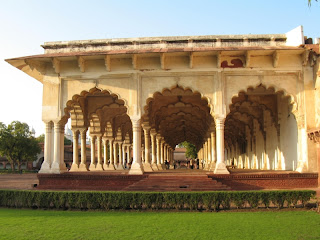Mughal emperor Shah Jahan and his architectures in the Indian scenario bear an exquisite testimony to Mughal architectures. During his reign between (1627–1658), he built some of the most delicate architectures in Delhi and Agra
TAJ MAHAL:
During the reign of Shah Jahan , India
The main part of the Agra Yamuna River
Building erected by Shah Jahan includes the following:
· Khas Mahal and Sheesh Mahal
Khas Mahal, built by Shahjahan clearly reflects the essence of later Mughal architecture. The Khas Mahal is an airy edifice; facing the specially laid Angoori Bagh. Windows closed with intricately pierced decorative stone screens present fabulous view of the riverfront. On three sides of this garden are residential quarters of women. Opposite to the Mussaman Burj and just below the Diwan-E- Khas hall is the Sheesh Mahal or the glass palace. It is believed to have been the harem dressing room and its walls are inlaid with tiny mirrors, which are the best specimens of glass mosaic decoration in India
· Musamman Burj
Musamman Burj is the most romantic, ornamental pavilion wherein lived two most beautiful and powerful Mughal queens-Nurjahan and Mumtaz Mahal. Here Shahjahan spent his last few years as a captive held by Aurangzeb. Shahjahan languished and dies looking at the Taj Mahal.
· Diwan-I-khas
Diwan-I-khas or the Hall of Private audience is a small hall with double marble columns inlaid with pietra dura decoration. Shahjahan built the structure between 1636 and 1637 and it is where the emperor used to receive the important dignitaries.
· Diwan-I-Aam
Diwan-I-Aam or the Hall of Public audience was again a building constructed by Shahjahan in 1628, replacing an earlier wooden structure. Here was kept the famous Peacock Throne ordered by Shahjahan. He met officials and commoners and listened to the petitioners in the Diwan-I-Aam.
· Macchi Bhavan
Situiated infront of Diwan –i- khas, is the Machchi Bhawan or the Fish Chamber. It is believed that it was used to rear gold fishes for the emperor. It is believed to have marble fountains and tanks once, for the purpose.
· Moti Masjid
Further north stands the Moti Masjid .It earned the nickname Pearl Mosque for it shined like a pearl. It is held that this mosque was constructed by Shah Jahan for his members of royal court.
· Nagina Masjid
Located nearby Moti Masjid is the Nagina Masjid or the Gem Mosque. This beautiful structure was built for the ladies of the Royal family. A luxurious bazaar, known as Mina Bazar, was functioning down the road from where royal ladies could purchase items standing in the balcony of Nagina Masjid.
· Mina Masjid
Shah Jehan built Mina Masjid near Diwan-i-Khas and this mosque was meant to be used by the emperor and the royal ladies. Thus, it was placed close to the palaces of the imperial women. This mosque was built, entirely of white marble.
Several of the buildings are made of pure marble with beautiful carvings. To cool off the rooms in the marble pavilions, the walls were hollow and filled with running water.
SHAHJAHANABAD:
Old Delhi Lahore
RED FORT:
The Mughal emperor, Shah Jahan, after ruling from Agra for eleven years, decided to shift to Delhi Delhi Lahore
Jama Masjid of Delhi Shahjahanabad
Shah Jahan erected many splendid monuments not only in India , but in Lahore Shalimar Garden

















That is nice collective information about Art and Architecture in shah jahan reign. Architecture is nice Art.
ReplyDeleteThanks Belal!
ReplyDeleteIt was very helpful. Thanks Joozia
ReplyDeleteIt was very helpful. Thanks Joozia
ReplyDeletevery nice and helpful! thanks a lot
ReplyDeletevery nice and helpful! thanks a lot
ReplyDeleteThank you very much for this great post.
ReplyDeletearchitects in Pakistan
it was very helpful
ReplyDeletethough it is helpful,light spelling mistake in mina masjid for shah jahan you wrote shah jehan
ReplyDeleteShah Jahan’s architectural legacy is truly awe-inspiring! Your post beautifully highlights how his vision combined grandeur, elegance, and intricate artistry, leaving behind masterpieces like the Taj Mahal and the Red Fort. It’s incredible to see how his work still influences architecture today. Thanks for such an enlightening read!
ReplyDeleteIf you are planning on a trip, do visit some of our best-rated tours:
👉 Golden Triangle Tour 3 Days
👉 Golden Triangle Tour 4 Days
👉 Golden Triangle Tour 5 Days
👉 Golden Triangle Tour with Ranthambore
👉 Golden Triangle Tour with Kerala
👉 Golden Triangle Tour with Kashmir
📞 For booking or any information, please call us:
🌐 www.tajindiatrip.com
📱 +91-962 700 0738
Let's join with Taj India Trip take your journey smooth, memorable, and affordable. Book now this Luxury Golden Triangle Tour and travel stress-free!